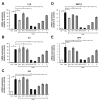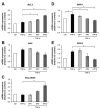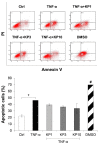Kaempferia parviflora Extract Alleviated Rat Arthritis, Exerted Chondroprotective Properties In Vitro, and Reduced Expression of Genes Associated with Inflammatory Arthritis
- PMID: 33799537
- PMCID: PMC8000004
- DOI: 10.3390/molecules26061527
Kaempferia parviflora Extract Alleviated Rat Arthritis, Exerted Chondroprotective Properties In Vitro, and Reduced Expression of Genes Associated with Inflammatory Arthritis
Abstract
Kaempferia parviflora Wall. ex Baker (KP) has been reported to attenuate cartilage destruction in rat model of osteoarthritis. Previously, we demonstrated that KP rhizome extract and its active components effectively suppressed mechanisms associated with RA in SW982 cells. Here, we further evaluated the anti-arthritis potential of KP extract by using multi-level models, including a complete Freund's adjuvant-induced arthritis and a cartilage explant culture model, and to investigate the effects of KP extract and its major components on related gene expressions and underlying mechanisms within cells. In arthritis rats, the KP extract reduced arthritis indexes, with no significant changes in biological parameters. In the cartilage explant model, the KP extract exerted chondroprotective potential by suppressing sulfated glycosaminoglycans release while preserving high accumulation of proteoglycans. In human chondrocyte cell line, a mixture of the major components equal to their amounts in KP extract showed strong suppression the expression of genes-associated inflammatory joint disease similar to that of the extract. Additionally, KP extract significantly suppressed NF-κB and MAPK signaling pathways. The suppressing expression of necroptosis genes and promoted anti-apoptosis were also found. Collectively, these results provided supportive evidence of the anti-arthritis properties of KP extract, which are associated with its three major components.
Keywords: Kaempferia parviflora; anti-arthritis; anti-inflammation; chondroprotection; inflammatory joint disease.
Conflict of interest statement
The authors declare no conflict of interest. The funders had no role in the design of the study; in the collection, analyses, or interpretation of data; in the writing of the manuscript, or in the decision to publish the results.
Figures






Similar articles
-
Ethanolic extract of Kaempferia parviflora interrupts the mechanisms-associated rheumatoid arthritis in SW982 culture model via p38/STAT1 and STAT3 pathways.Phytomedicine. 2019 Jun;59:152755. doi: 10.1016/j.phymed.2018.11.015. Epub 2018 Nov 14. Phytomedicine. 2019. PMID: 31005814
-
Anti-arthritis Effects of Zingiberaceae Extracts on Models of Inflammatory Joint Disease.Planta Med. 2023 Aug;89(9):890-902. doi: 10.1055/a-2044-9129. Epub 2023 Mar 20. Planta Med. 2023. PMID: 36940710
-
Kaempferia parviflora extract inhibits TNF-α-induced release of MCP-1 in ovarian cancer cells through the suppression of NF-κB signaling.Biomed Pharmacother. 2021 Sep;141:111911. doi: 10.1016/j.biopha.2021.111911. Epub 2021 Jul 12. Biomed Pharmacother. 2021. PMID: 34328090
-
Kaempferia parviflora Extract Inhibits STAT3 Activation and Interleukin-6 Production in HeLa Cervical Cancer Cells.Int J Mol Sci. 2019 Aug 29;20(17):4226. doi: 10.3390/ijms20174226. Int J Mol Sci. 2019. PMID: 31470515 Free PMC article.
-
A systematic review and meta-analysis of animal and human studies demonstrates the beneficial effects of Kaempferia parviflora on metabolic syndrome and erectile dysfunction.Nutr Res. 2024 Feb;122:80-91. doi: 10.1016/j.nutres.2023.12.001. Epub 2023 Dec 5. Nutr Res. 2024. PMID: 38194854
Cited by
-
Network Pharmacology and Molecular Docking-Based Approach to Explore Potential Bioactive Compounds from Kaempferia parviflora on Chemokine Signaling Pathways in the Treatment of Psoriasis Disease.Int J Mol Sci. 2025 May 29;26(11):5243. doi: 10.3390/ijms26115243. Int J Mol Sci. 2025. PMID: 40508056 Free PMC article.
-
Kaempferia parviflora rhizome extract exerts anti-obesity effect in high-fat diet-induced obese C57BL/6N mice.Food Nutr Res. 2023 Aug 23;67. doi: 10.29219/fnr.v67.9413. eCollection 2023. Food Nutr Res. 2023. PMID: 37691744 Free PMC article.
-
The Chemistry and the Anti-Inflammatory Activity of Polymethoxyflavonoids from Citrus Genus.Antioxidants (Basel). 2022 Dec 22;12(1):23. doi: 10.3390/antiox12010023. Antioxidants (Basel). 2022. PMID: 36670885 Free PMC article. Review.
References
-
- Woetzel D., Huber R., Kupfer P., Pohlers D., Pfaff M., Driesch D., Häupl T., Koczan D., Stiehl P., Guthke R., et al. Identification of rheumatoid arthritis and osteoarthritis patients by transcriptome-based rule set generation. Arthritis Res. Ther. 2014;16:R84. doi: 10.1186/ar4526. - DOI - PMC - PubMed
MeSH terms
Substances
Grants and funding
LinkOut - more resources
Full Text Sources
Other Literature Sources
Medical

